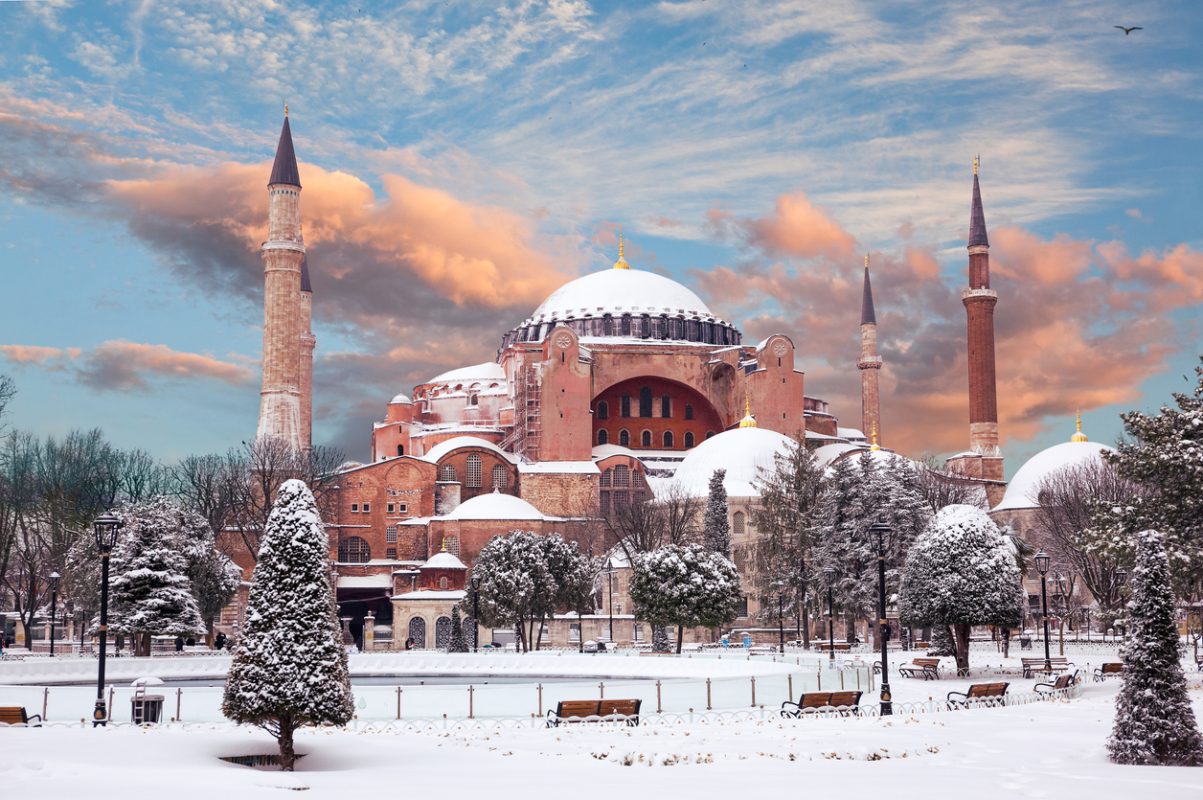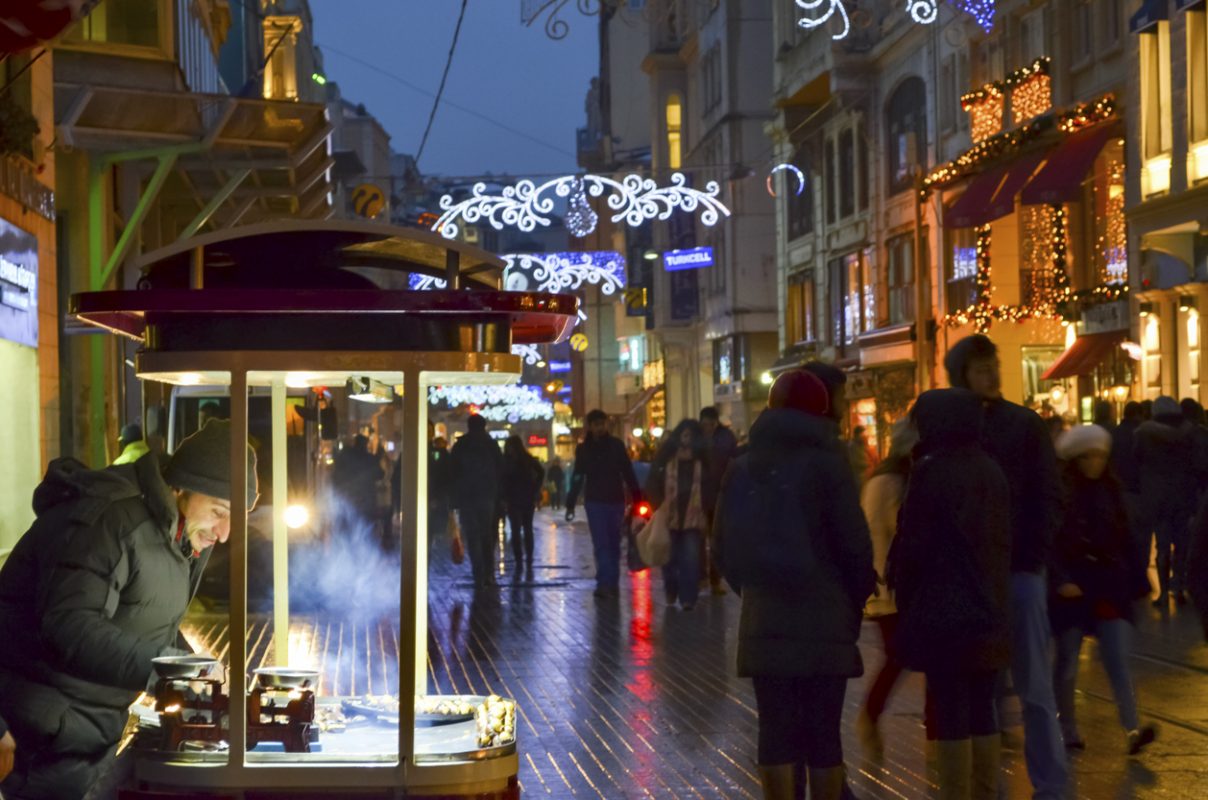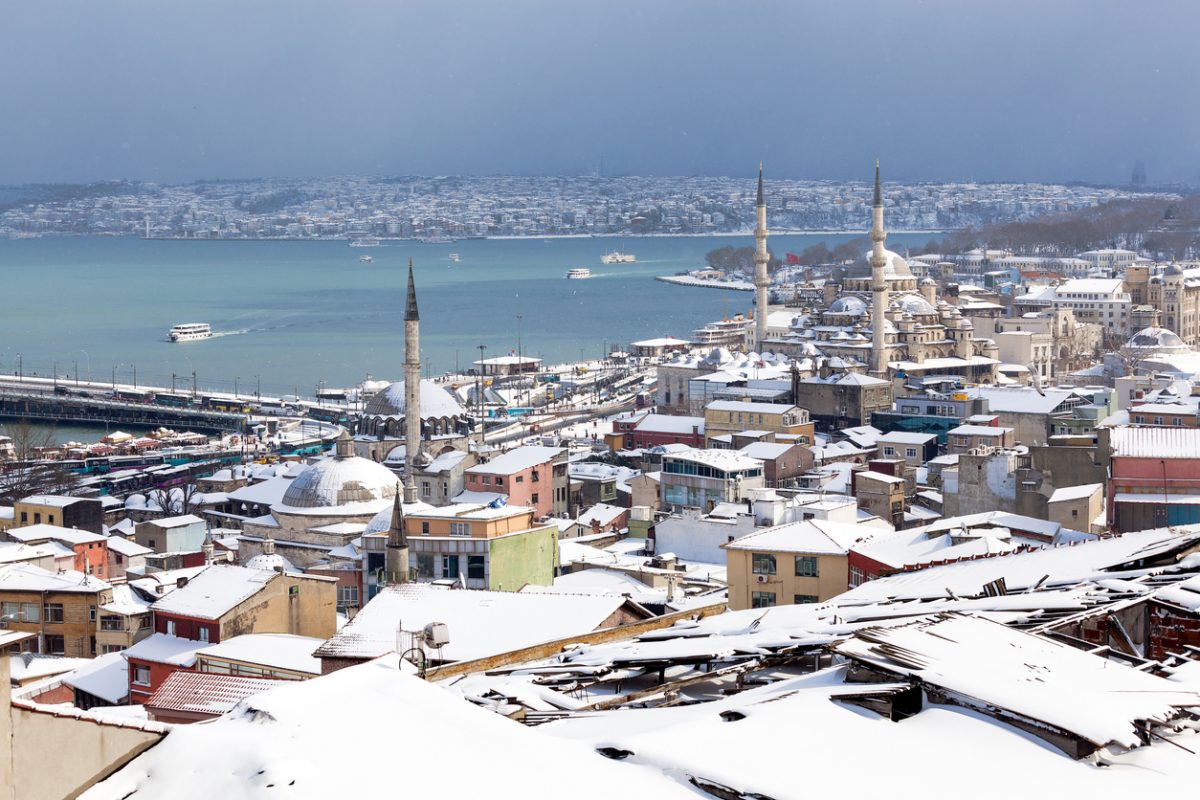Does it snow in Istanbul, the largest city in Turkey? What’s there to do when it has snowy weather? Read on for all my tips!
Istanbul’s the city that straddles two continents, famous for its centuries of history and gorgeous mosques and minarets…
And when it’s cloaked in a fresh, gentle layer of white snow, it’s all the more scenic!
Snowy Istanbul may sound surprising, and while it doesn’t happen every winter, it’s not uncommon!
The city’s characteristic warmth is not quenched by the cold; instead, it trades its vivacious summer energy for a more introspective, subdued charm.
I’ve visited Istanbul three times in the winter, and here’s my full explanation of the ever-popular question does it snow in Istanbul?
Does it snow in Istanbul?

The simple answer is, yes, it does.
However, snow in Istanbul is less predictable than in other regions in Turkey.
Despite its location and temperate climate, snowfall can occur but it’s not a regular feature every winter.
However, snowfall is not evenly distributed across the months and it can vary dramatically from year to year (some years, it doesn’t snow at all).
The city’s snowfall tends to be concentrated in a few snowstorms each year, often taking residents and visitors by surprise!
The duration of snowfall varies from a quick dusting to a few days of continuous snow.
On rare occasions, a larger snowstorm may envelop the city.
So snow in Istanbul is a bit of an enigma – unpredictable yet enchanting!
When does it snow in Istanbul?

Snow in Istanbul doesn’t follow a strict timetable, but its arrival is most probable in the colder months of winter, specifically in January and February.
However, the snow can start as early as December and continue into March, albeit less frequently.
Below is a table that provides a clearer picture of the likelihood of snowfall in Istanbul during the winter months:
| Month | Average Snowfall (inches) | Average Snowy Days |
|---|---|---|
| November | Very minimal | <1 |
| December | 2.4 (6 cm) | 1 |
| January | 4.3 (11 cm) | 5 |
| February | 4.1 (10 cm) | 2 |
| March | 1.8 (4.5 cm) | 1.6 |
Keep in mind that this table is based on averages, and snowfall can vary significantly from year to year.
Plus, Istanbul’s snowfall is unpredictable, often coming in a few large snowstorms that can quickly transform the city’s landscape!
Why does it snow in Istanbul?
As Istanbul sits comfortably in Southern Europe, just above the Middle East, and places in Southern Turkey like Antalya and Kas are famous for their warm winter weather, it comes to many as a surprise that Istanbul experiences snowfall.
Istanbul’s winter weather patterns are shaped by its unique geographical location, where the city straddles both Europe and Asia and is split by the Bosphorus Strait, which connects the Black Sea and the Sea of Marmara.
The city’s snowfall can be largely attributed to cold air masses moving southwards from the Balkans and Eastern Europe during the winter months.
These cold fronts often meet with humid air over the Black Sea, which can result in snow if the temperature conditions are just right.
So, while many people might not initially think of snowfall when imagining Istanbul, it’s a weather phenomenon that does occur!
Yet, owing to the city’s changing climate, the average snow days are less, making snowy Istanbul a less frequent sight but all the more special.
It does snow much more in places like Cappadocia and Ankara, Turkey’s capital.
Istanbul’s microclimates

Istanbul’s unique geographical position, stretching over two continents and surrounded by water bodies, creates a variety of microclimates within the city.
These microclimates can affect local weather patterns, leading to interesting scenarios where it may be snowing in one part of the city and not in others!
A microclimate is a localized atmospheric zone where the climate differs from the surrounding area.
This can be caused by a variety of factors, including elevation, urban development, proximity to water bodies, and vegetation.
In Istanbul, the city’s diverse topography contributes significantly to the creation of microclimates.
The city is characterized by an interesting blend of hills, valleys, and water bodies, which all interact with the atmospheric conditions to affect local temperatures and precipitation patterns.
The Bosphorus Strait and the Sea of Marmara can have a moderating effect on the climate, keeping the coastal areas a bit milder.
Conversely, the hilly areas, particularly those located further inland and at higher elevations, can be colder and more likely to receive snow.
The urban areas, especially the city centre, can experience what’s known as the “urban heat island” effect.
This is a phenomenon where urban regions are significantly warmer than their surrounding rural areas due to human activities and high-density infrastructure.
This can often lead to lower snowfall in central Istanbul compared to the suburbs and the outskirts of the city.
Snowy activities in Istanbul
Should you find yourself in Istanbul during a rare snowfall, there are a myriad of winter activities!
First and foremost, simply walking around the city is enchanting.
The city’s iconic landmarks such as the Blue Mosque, the Hagia Sophia, and Topkapi Palace take on a new aura under a gentle blanket of snow.
It’s an ideal time to capture the city’s monuments in a new, different light!
Snowball fights are not uncommon amongst local children and enthusiastic tourists in parks such as Gulhane and Yildiz.
You could also take a ferry ride across the Bosphorus and watch as snowflakes fall gently onto the icy blue waters.
When you feel the chill seeping in, seek out the comfort of one of Istanbul’s numerous museums.
The Istanbul Modern, Pera Museum, or Sakip Sabanci Museum all provide warm respite, housing an array of impressive collections that can keep you enthralled for hours.
Alternatively, indulge in the traditional Turkish experience of a hammam, where the warmth of the steam and a rejuvenating scrub will chase away the winter cold.
In the heart of the city, there are countless restaurants serving up hearty Turkish dishes that are perfect for the cold weather.
Warm up with a steaming bowl of lentil soup (Mercimek çorbası) or a delicious plate of baked beans (kuru fasulye), followed by a hot cup of Turkish tea.
For skiing enthusiasts, while there isn’t skiing directly in Istanbul, there are ski resorts not too far away!
Kartepe, the closest ski resort to Istanbul, is just a couple of hours’ drive from the city and is one of the best places to visit in Turkey in winter.
With well-groomed slopes and stunning winter views, it’s a popular place if you’re looking for a snowy getaway!
Tips for travelling to Istanbul in snowy weather

Here are some useful tips for if you’re visiting Istanbul and it snows!
Clothes
Dressing in layers is the most effective way to keep warm.
Start with a good-quality thermal base layer, add a warm middle layer like a fleece or a wool sweater, and top it off with a waterproof and windproof outer layer.
Don’t forget a warm hat, gloves, and a scarf.
Insulated and waterproof shoes with a good grip are a must, as sidewalks can become slippery with ice.
Transport
While Istanbul has an extensive public transport network, snow can disrupt services.
If heavy snow is forecasted, be prepared for possible delays or cancellations.
The metro system is generally more reliable during snowy conditions.
But the experience of a ferry ride in the snow across the Bosphorus is hard to match!
Accommodation
Booking accommodation in central locations such as Sultanahmet or Taksim can work well in the winter!
These areas have numerous tourist attractions within walking distance, which can be a significant benefit if public transportation is disrupted.
Be safe
Be cautious while walking on icy pavements!
Also, remember that daylight hours are shorter in the winter, so plan your outdoor activities accordingly.
Embrace indoor activities
If the snowfall is too heavy for being outdoors, consider visiting some of Istanbul’s world-class museums, art galleries, or even a traditional hammam.
Remember, Istanbul is a gastronomic paradise – you could use this time to explore the city’s cuisine!
FAQs about snow in Istanbul
Here are some answers to ever-popular questions about snow in Istanbul!
Does it Snow in Istanbul in November?
November in Istanbul marks the beginning of winter.
However, snow during this month is relatively rare. The average temperature ranges between 8°C to 15°C.
If snow does occur, it usually doesn’t stick around for long!
Does it Snow in Istanbul in December?
Snow in Istanbul in December is a bit more common, though not a guarantee.
The city’s temperatures drop significantly with averages between 5°C to 10°C.
If there is snowfall, it’s typically light and doesn’t last very long.
Does it Snow in Istanbul in January?
January is usually the coldest month in Istanbul, with temperatures often dropping below freezing.
Snowfall is more likely during this month, although heavy snow is still infrequent.
If it does snow, it can create a unique atmosphere in the city.
Does it Snow in Istanbul in February?
Snowfall in February is similar to January.
Temperatures remain low, and there are higher chances of snow.
While snow is still not a common occurrence, it’s more likely than in the earlier winter months.
I’ve visited Istanbul in February and found the weather to be quite mild, much warmer than London was at the time.
Does it Snow in Istanbul in March?
March ushers in the early signs of spring in Istanbul, and snowfall becomes less common.
However, it’s not unheard of for a late winter snowfall to occur, so always check the forecast.
How Cold Does it Get in Istanbul in Winter?
Winter in Istanbul is relatively mild compared to other European cities.
Average temperatures range between 3°C to 9°C (37°F to 48°F) in the coldest months of January and February.
Night temperatures can sometimes fall below freezing, especially when a cold front moves in!
Are you prepared for snowy Istanbul?
Istanbul certainly does see snow, but it’s rare. Generally, the winters here aren’t as harsh as elsewhere in Europe – but the white stuff does occasionally make an appearance.
If you’re visiting Istanbul in winter and have freezing conditions on the forecast, embrace it – as it probably won’t last for long!

